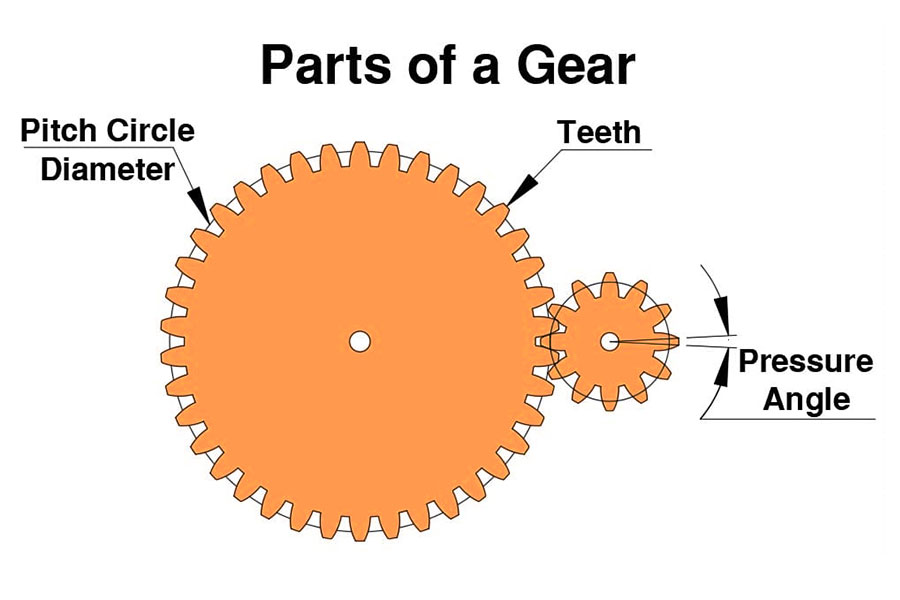Gear, as the core part ofmechanical transmission, is widely usedBy carandindustrial equipmentthrough precise tooth meshing to transmit power and motion.The manufacturing method directly affects the durability, noise control and transmission efficiency of the product.Precision castingis suitable forlarge-scale low-cost production, while CNC machining can achieve complex shape and high precision.With advancements in 3D printing, the design boundaries of lightweight and customised gears are being redefined.
How to create gears requires a combination of material characteristics, cost budgets and application scenarios.LS company provides a one-stop shop for everything fromonline CNC precision machiningtometal/plastic 3D printingand then rapid prototyping verification.We can match the most optimal process according to your specific needs.Whether it's standardised products or innovative design, LS'professional team help shorten product development cycles and improve product competitiveness.

What are Gears?
1.Core functions and technical values
The precise transmission of power and movement of gears through tooth surface meshing has the following irreplaceable technical values:
- High power density: Gears with a diameter of only 50mm can deliver more than 200kW of torque in an aircraft engines.
- Accurate motion control: The clockwork industry uses a combination of escapement mechanisms and gears to achieve timing accuracy with a daily error of less than ±0.5 seconds.
- Powerful system integration: Planetary gearboxes are 99% faster and more than 70% faster than conventional gearboxes.
- Full lifecycle cost advantage: The fatigue life of automobile transmission gears can reach 10⁸ cycles, the comprehensive maintenance cost is only 1/5 of hydraulic transmission.
2.Key Parameter: How to Build Gears
Gears must be designed and manufactured in strict conformity with the ISO 1328 international standard system,the core parameters of which constitute a multidimensional performance evaluation system:
- Module (m): ISO standards specify a general range of 2.5-30mm.The larger the modulus, the stronger the gears, but the greater the weight and noise.Wind turbine gearboxes, for example, are typically designed with large modules above 35mm to cope with extreme loads.
- Pressure angle(a): The key parameter that affects the contact strength and transmission efficiency of tooth surfaces, of which the pressure angle of 20 ° is the most widely used parameter in automobile field.Under high pressure,a pressure angle of 25 ° can be selected to improve the bending resistance of the tooth root.
- Crown height factor (ha): Standard values are 1.0-1.2 and tooth root reinforcement factors commonly used aerospace field are 1.6-1.8.
- Spiral angle (β): The core parameters of helical gear design are 8-15 ° helical angle which reduces vibration noise by more than 80%. Using spiral topology optimization,such as LS company's AI driven design platform, can significantly improve engagement smoothness.
3.Construction of Mainstream Type and application scenarios
Different types of gears correspond to different manufacturing methods and application scenarios. How to make gears requires a combination of performance requirements:
| Gear type | Construction process | Typical applications | Performance advantages |
| Spur gear | Sand casting/CNC gear hobbing | Conveyor, agricultural machinery gearbox. | Low cost and easy to mass produce. |
| helical gear | Precision gear hobbing/powder metallurgy injection molding | Automotive 8AT-speed automatic transmission, industrial robots. | Smooth meshing, increased load-bearing capacity by 30%. |
| Worm gear | Electrolytic polishing/ceramic based composite materials | Elevator braking system, deep-sea drilling rig. | Self locking function, resistant to high temperature corrosion. |
The construction of gears needs to revolve around the performance cost feasibility triangle decision - spur gears pursue economies of scale, helical gears focus on dynamic performance, and worm gears focus on extreme working condition adaptation.LS company can quickly match the optimal solution through a process database (including 2000+operating parameters), helping you achieve precise construction from design to mass production.

Why gear manufacturing methods impact your business?
1.The game between cost and quality
| Type of process | Unit cost | Life cycle | Defect rate | Additional quality inspection costs |
| Sand casting gears | $5-8 | 3-5 years | 3%-5% | $8-15 per piece |
| Gear CNC precision machining | $100-200 | 8-10 years | <0.1% | $0.5-2 per piece |
| 3D-printed gears | $300-500 | 2-3 years | <0.05% | $1-3 per piece |
Key findings:
- For car companies, the cost of a CNC gears is 20 times higher, but the cost of its life cycle has fallen by 40% because of a five-year extension in service life.
- 3D printing may seem expensive for medical devices, at around $500 per piece, but it avoids the 200 thousand mold development costs of traditional processes and is suitable for small batch customization needs.
- The defect rate in casting is 3% per cent, which means an additional 12,000 to 22,500 inspection cost every 10,000 items produced, with a return rate of up to 15 per cent.
2.Industry experiences and case studies
Success story: Japanese Robot Manufacturer's 30% top secrets
- Process innovation: Reduce transmission noise from 72dB to 58dB with cemented grinding teeth and ion implantation surface strengthening.
- MARKET RETURN: Consumers are 30% more willing to buy silent robots.With ISO 1328-1 standard certification,the company successfully entered the high-end industrial robot market with a gross margin of 45% (industry average of 35%).
Failures: Medical equipment recall crisis
- LESSON OF FAILURE: A enterprise that used low-priced injection molding gear to cut costs was forced to recall 100,000 devices due to material fatigue and a faulty CT scanner transmission system, causing a $120 million loss.
- Supplier solution: LS company offers titanium alloy 3D-printed gears (with a fatigue life of 10⁹cycles) at a cost of only $20 per piece, but avoids deadly risks.
3.Strategic decision-making framework
The enterprise needs to construct a process decision matrix, which evaluates from several aspects:
| Decision dimension | Evaluation indicators | Weight | LS company tool support |
| Batch Size | Annual output (100 vs. 100 thousand pieces) | 30% | Online cost simulator: automatically recommend processes based on input output. |
| Load conditions | Static torque/dynamic impact/temperature environment | 35% | FEA simulation platform: predicting fatigue life of different processes. |
| Industry certification | IATF16949/ ISO 1328/ NADCAP | 35% | Certification compliance package: pre-approval documents+process benchmarking report. |
- Examples of decisions:
Automobile companies (100 thousand pieces/year, dynamic torque 500N/ m, IATF 16949 certification): Recommended CNC gear + carburizing quenching combination process recommended. LS reduces costs by 18% compared to traditional processes through AI topology optimization design, while ensuring the 6σ quality standard.
Medical Enterprises (500 pieces peryear, Sterile Environmental Requirements, ISO 13485 certification): Complete risk of contamination of cutting fluid by metal 3D printing + electrolytic polishing technology and rapid approval by FDA.
Which gear manufacturing method is right for you?
Numerical control cutting (high precision preferred)
1.Case in point: Swiss medical equipment company Titanium alloy dental implant wheel (module 1.5, 8mm in diameter).
2.Process pain points:
- Titanium alloy have high hardness (HV 1500-2000), poor thermal conductivity (16 W/m.K),and are prone to tool wear and thermal deformation during traditional machining.
- The implant wheel must meet the ISO 10993 biocompatibility standard with surface roughness Ra<0.4 μm to avoid cell adhesion risk.
3.LS Company Solution:
- Five-axis CNC machine tool (worktable repeatability accuracy ± 1.5 μm) combined with PCD coated cutting tools (10 fold increase in 10 life).
- Thermal deformation was controlled by constant temperature cutting system (25 ±0.5 ℃) and ultrasonic vibration assisted machining (amplitude 5 μm, frequency 20kHz), reduce cutting force by 30%.
- Surface Microtexturing: Using Laser micronanotechnology, 0.2 μm micro grooves is created on the surface of the tooth to promote bone integration.
4.Operating Performance:
- FDA 510(k) certification: Through a full process digital tracking system (ISO 13485 standard compliant).
- Mass production data: 500 orders with a reduced lead time of 4 weeks (compared to 8 weeks required for traditional processes) and an increase in production from 85% to 99.2%.
- Market Premium: The unit price rose 25% due to the premium dental brand's ultra-quiet design (with less than 45dB of noise).
Precision casting (low-cost mass production)
1.Case study: Chinese auto supplier gearbox gears (500 thousand pieces per year, 3 modules, 2.1 kg total weight).
2.Process pain points:
- Microcracks (fatigue life less than 10⁷cycles) occur in die casting gears of Aluminum alloy under high speed impact.
- Thin-walled structures (0.8mm wall thickness) are prone to deformation due to different solidification and solidification shrinkage rates.
3.LS company optimization plan:
- Vacuum high pressure casting (pressure 0.3MPa, oxygen content<50ppm) reduced porosity defects and increased the qualification rate for X-ray examination from 92% to 99.6%.
- Local heat treatment: Gear nitriding (depth 0.2mm, hardness 62HRC)+T6 solution treated core with a tensile strength of 310MPa (40% higher than traditional process).
- Mold flow analysis optimization: Shrinkage rate was reduced from 1.2% to 0.3% by adjusting gate position position through Moldflow simulation.
4.Economic benefits:
- Unit cost: 3.2 (from 5.2), resulting in annual cost savings of $10.4 million.
- Quality return: Fatigue life is 10⁸ cycles (compared to international standard ISO 6336) and we have a 10-year warranty agreement with the host factory.
- Delivery capability: Parallel production of 16 die-casting machines with a monthly production capacity of 62 thousand pieces, an overall efficiency of 89%.
Powder Metallurgy (Micro Gear Expert)
1.Case study: Stainless steel gear for German insulin pump (module 0.3, total assembly size Φ 12mm).
2.Technical challenges:
- Microscale meshing: The modulus of 0.3 is only 0.6mm tooth width, and traditional gear hobbing techniques donot guarantee tooth profile.
- Material requirements: Medical grade 316L stainless steel shall balance biocompatibility (corrosion resistance, Cl concentration<100ppm) and abrasion resistance (friction coefficient<0.1).
3.LS company's breakthrough technology:
- Metal Injection Molding: Powder size 80-150 μm,injection temperature 1450 °C, density 7.4g/cm³ (near theoretical value).
- Hot isostatic pressing: Elimination of internal defects at 1100 °C/100MPa argon with a tensile strength of 820MPa (ISO 683 standard).
- Surface laser hardening: 3D contour scanning laser quenching (power 2kW, scanning speed 50mm/s), surface hardness HRC 60, wear-resistant layer thickness 0.1mm.
4.Clinical validation:
- Lifetime test: 8,000 hours of uninterrupted wear and tear under conditions that mimic blood glucose fluctuations (2N /m torque, 500rpm).
- Compliance: Certified by ISO 13485 medical device quality management system certification and recognized by CE Mark.
- Cost advantages: 90% reduction in mold costs compared to precision machining, with a mass production unit price of 1.8 (from 6.5).
Metal 3D printing (innovative design breakthrough)
1.Case study: NASA's Inconel 718 satellite gear (4.7 kg total weight, module 2.5).
2.Space environment challenges:
- Extreme temperature: It needs to cycle between liquid nitrogen at -196 °C and direct sunlight at+150 °C.
- Radiation corrosion: The risk of material embrittlement caused by galactic cosmic rays.
- Lightweight requirement: Satellite launch weight weight is limited to 500kg and weight requirements are reduced by 30%.
3.LS Company's technical path:
- Topology optimization design: ANSYS parametric modeling generated hollow root + honeycomb sandwich structures with densities down to 4.2g/cm³ (35% weight reduction).
- Selective laser melting: 300 W laser power, scanning speed 600mm/s, 20 μm thickness, density>99.95%.
- Post-treatment innovation: Surface vapor deposition of TiN coating with reduced friction coefficient to 0.08 and temperature resistance to 1000 °C (ASTM E112 standard).
4.Mission achievements:
- Successful launch: More than 2,000 hours of low-Earth orbit with SpaceX transporter Launch Vehicle 3 rocket without any problems.
- Performance data: Under10⁴ N.m of torque, the 2.5 modulus gear tooth surface contact strength value of 920MPa (300% higher than conventional casting), 35% less system weight, and $2 million/kg in launch costs savings.
- Patent layout: Five international PCT patents were filed around the gradient function gear technology.

How to Implement the Optimal Strategy?
1.Requirement diagnosis tool
LS company's digital decision-making platform
- Enter three main parameters: Torque (N.m), speed (rpm) and batch size (parts), and the AI algorithm automatically matches the best process (CNC/casting/powder metallurgy/3D printing).
- Support direct upload CAD model and real-time simulation gear meshing performance.
- Industry cases:
Car customers: 500Nm of Input torque, 1000rpm, fifty thousand pieces mass produced. precision casting+carburizing quenching solution is recommended, which can reduce the cost by 32% compared with traditional process.
2.Global supply chain geographic strategy
| Requirement type | Recommended regions | Cost/Performance Advantage |
| High precision requirements | Germany/Japan | Tolerance control ≤0.005mm, surface roughness Ra ≤ 0.4 μm. |
| Cost sensitive type | China/India | Scale effect reduces costs by over 30% and shortens delivery cycles by 40%. |
| Innovative design requirements | USA/Switzerland | Support topology optimization and integrated printing, reducing weight by 35%-50%. |
3.Quality control checklist: mandatory inspection items and LS certification services
| Testing items | Testing method | LS Company Standard | Industry Benchmarking |
| Profile Error | Double meshing instrument (± 0.008mm). | ISO 3487-1:2020 | Automotive industry ≤0.01mm |
| Hardness gradient | Micro Vickers hardness tester (5-300 μm). | ASTM E1444 standard | Aerospace HRC 58-62 |
| Microstructure | Electron microscope (grain size ≥ 5). | GB/T 6394-2015 | Cast iron ≥ Grade 4, alloy steel ≥ Grade 3 |
| Surface roughness | Contour meter (Ra 0.8-0.05 μm). | ISO 4287-1996 | Medical device Ra ≤ 0.4 μm |
4.Cost optimization techniques: LS dedicated cost reduction plan
Optimization of Casting Process
- Modular mold design: Change the traditional 20-piece first die test to a 40-piece integrated die test, reducing the cost of mold opening by 30%.
- Case in point: After the modification of the gear mold of the Chinese customer gearbox, the cost increased from $3.2 per piece to $2.2 per piece, with an annual production of 500 thousand pieces, saving $4 million.
- Waste rate control: Using thermostatic (HIP) process, density increased to 99.5% and material utilization rate increased from 65% to 92%.
- Multiplex laser parallel production: 300% efficiency improvement in EOS M300-4 equipment and printing speed of 200 mm³/min.
- Case in point: Order 200 USPS Gears and reduce the lead time from 14 weeks to 7 days, saving $180 thousand.
- Material reuse technology: Supports metal powder recovery (recoverable ≥95%) and reduces material costs by 40%.
5.Lump sum option provides solution
- Dual-source procurement: CNC+casting dual-track track verification, key components using two simultaneous production processes to ensure continuity of supply.
- Vendor Managed Inventory: Establishment of secure inventory at client locations (e.g. Munich warehouse, Germany), reducing response time to 24 hours.
- Technical iteration insurance: Provides free technical training in new technologies (e.g. powder metallurgy → metal injection molding migration) to reduce the risk of technological obsolescence.
What are the four core competencies of LS?
1.Full-process capacity coverage: We are a global supplier with CNC cutting (five-axis coupling), precision casting (vacuum high pressure), powder metallurgy (MIM+HIP) and 3D printing (SLM/DMLS) capabilities.
2.Digital empowerment: Artificial intelligence process design platform,10-minute output optimization solution, design defect rate reduced by 60%. Digital Twin Service,A virtual gearbox prototype is built with 92% accuracy in predicting its service life.
3.Localized service network: 6 global production bases+20 regional service centers to support 48-hour emergency response.
4.Full lifecycle support: Gears as a service model, provides a one-stop solution from design to scrap recycling, reducing total customer ownership costs by 30%.

Summary
Gear is a kind of mechanical component which can realize power transmission and motion control by precise cutting or shaping tooth structures.The choice of gear directly determines the accuracy, strength and cost-effectiveness of the product. LS Company is a professional supplier of online CNC machining, custom parts design, and 3D printing services,providing flexible custom gear manufacturing solutions for different application scenarios to help enterprises improve product competitiveness.If you need more information about gear manufacturing solutions, feel free to contact LS company. We provide professional online CNC machining, custom parts, 3D printing and prototype production services.
Disclaimer
The content of this page is for informational purposes only.LS SeriesNo representations or warranties of any kind, express or implied, are made as to the accuracy, completeness or validity of the information. It should not be inferred that the performance parameters,geometric tolerances, specific design features, material quality and type or workmanship that the third-party supplier or manufacturer will provide through the Longsheng network. This is the responsibility of the buyerAsk for a quote for partsto determine the specific requirements for these parts.pleaseContact usLearn moreEFOrmation.
LS Team
LS is an industry-leading companyFocus on custom manufacturing solutions.With over 20 years of experience serving more than 5,000 customers, we focus on high precisionCNC machining,Sheet metal fabrication,3D printing,Injection molding,metal stamping,and other one-stop manufacturing services.
Our factory is equipped with more than 100 state-of-the-art 5-axis machining centers and is ISO 9001:2015 certified. We provide fast, efficient and high-quality manufacturing solutions to customers in more than 150 countries around the world. Whether it's low-volume production or mass customization, we can meet your needs with the fastest delivery within 24 hours. chooseLS TechnologyIt means choosing efficiency, quality and professionalism.
To learn more, please visit our website:www.lsrpf.com
FAQs
1.Why can't machinery be without gears?
Gears are mechanical parts with tooth profiles that transmit power and motion through meshing, just like mechanical teeth. car engines and factory machine tools rely on gears for their rotating parts. Without gears, machinery cannot precisely control speed, torque or direction.
2.How does the method gears are manufactured affect their service life?
Foundry gear is low-cost, but prone to porosity defects, short lifespan. CNC gears surface smooth, high precision, fatigue life up to 10 weeks. 3D-printed gear optimized internal structure,high temperature resistance, corrosion resistance, suitable for extreme environments.
3.How do you determine what type of equipment a company needs?
High-speed transmission selects helical gear, self-lock requires selection of worm gears.Choose from 3D-printed up to 500 pieces and cast up to 100000 pieces.Aeronautical gears need to be heat resistant (choose titanium alloy+heat treatment) and household appliance gears need to be quiet (choose nylon+surface coating). Contact LS company for the best solution.
4.What are the problems with low surface roughness of gears?
Gear noise ≥70 dB (eg tractor tractor gearbox at noise and roughness greater than 3.2 μm. Rapid wear and tear reduced lifespan by 30%-50% Ra >1.6 μm.







